Sapphire Vintage Engagement Rings: A 1920s Perspective
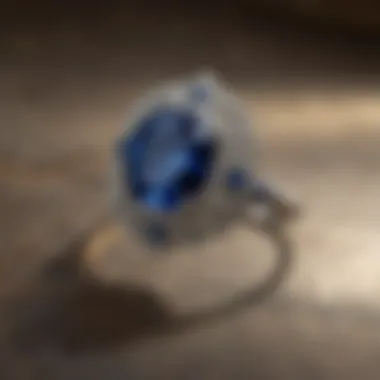

Intro
Sapphire vintage engagement rings from the 1920s represent more than just adornment; they embody a confluence of history, artistry, and societal values. The 1920s, often referred to as the Roaring Twenties, was an era of significant cultural transformation, and its impact on jewelry design cannot be overstated. This period saw the emergence of new materials, innovative techniques, and the bold use of gemstones. Among these, the sapphire gained particular prominence, reflecting the sophisticated tastes of a generation that was redefining romance and commitment.
In this article, we will explore the various dimensions of sapphire vintage engagement rings, starting with an overview of gemstones themselves. We'll delve into the historical significance of sapphires, examining their role and symbolism throughout different cultures. Furthermore, we will analyze the craftsmanship involved in creating these unique rings and their enduring appeal today.
Through this comprehensive guide, enthusiasts, collectors, and designers will gain valuable insights into why sapphire engagement rings from the 1920s remain sought-after pieces that connect the past to contemporary preferences.
Historical Context of the 1920s
The 1920s, often called the Roaring Twenties, was a significant decade that shaped various aspects of society, including fashion and jewelry. This era was marked by a blend of post-World War I optimism and rapid cultural changes. Understanding this context is crucial for appreciating sapphire vintage engagement rings, as the rings reflect the societal values and artistic movements of their time.
Cultural shifts during this period influenced what people wore, especially in terms of personal adornments. People began to express their individuality with more boldness. This change opened doors for sapphires, which gained popularity due to their unique beauty and rich symbolism.
Another key element of the 1920s is the emergence of the Art Deco movement. This artistic style not only defined architecture and interior design but also profoundly affected jewelry design. The detailed craftsmanship and geometric patterns of Art Deco pieces resonate strongly in vintage engagement rings featuring sapphires, showcasing both style and sentiment.
Additionally, the role of women began to change during this decade. The flapper movement encouraged women to assert their independence and embrace modernity. Jewelry became an essential part of their identity, with engagement rings reflecting their new status and tastes. These transformations influenced how sapphire rings were designed, how they were perceived, and how they were valued.
In summary, the historical context of the 1920s is pivotal in analyzing sapphire vintage engagement rings. By exploring the cultural shifts, the Art Deco movement, and the evolving role of women, one gains deeper insight into the significance of these beautiful artifacts.
Cultural Shifts and Their Impact
Cultural shifts in the 1920s had lasting impacts on various fields, including fashion and jewelry. The aftermath of the war ushered in a desire for joy and extravagance. Individuals sought new ways to express themselves, and this included their choice of jewelry. Sapphire engagement rings, with their vivid colors and durability, became an appealing option for those wanting to symbolize their commitments. The decade’s cultural changes allowed for a greater appreciation of unique gemstones beyond traditional diamonds.
Art Deco Movement Overview
The Art Deco movement stands as a defining feature of the 1920s. It embraced a modern aesthetic that was bold and geometric. This style heavily influenced jewelry, including the designs of sapphire engagement rings.
Defining Characteristics
Art Deco is characterized by its geometric shapes and intricate details. Rings from this period often feature sharp angles, symmetrical designs, and vibrant gemstones. The distinctiveness of Art Deco made it appealing for those wanting a statement piece. Sapphires fit well within this style, offering a spectrum of colors and adding to the visual allure of the rings. These characteristics are advantageous as they make such pieces timeless and sophisticated, appealing to a modern audience.
Influences on Jewelry Design
The Art Deco movement was influenced by various forms of art, including Cubism and neoclassicism. Jewelry designers adopted these styles and integrated them with precious metals and colorful stones. Sapphires, often paired with diamonds and emeralds, enhanced the luxurious vibe of jewelry pieces. This melding of influences made jewelry design during the 1920s innovative and multifaceted. Vintage engagement rings stand out as they reflect both historical artistry and contemporaneity.
The Role of Women in Jewelry Trends
In the 1920s, women began to assert their independence and challenge societal norms, which had a profound impact on jewelry trends. The rise of the flapper signified a shift in attitudes towards femininity, leading women to choose jewelry that reflected their newfound freedom. Engagement rings became not only symbols of love but also personal statements. Sapphires, with their rich colors and robust nature, appealed to women seeking elegance and strength in their jewelry choices. The transformation in women's roles helped shape a unique style in sapphire vintage engagement rings.
Sapphire: The Stone of Choice
Sapphire is not merely a gemstone; it embodies a fusion of beauty, strength, and symbolism that has made it a preferred choice for vintage engagement rings, particularly in the 1920s. During this time, sapphire's allure became pronounced, making it a mark of elegance and sophistication. Its unique properties and historical significance solidify its status as the stone of choice for these elaborate rings.
Properties of Sapphire
Color Varieties
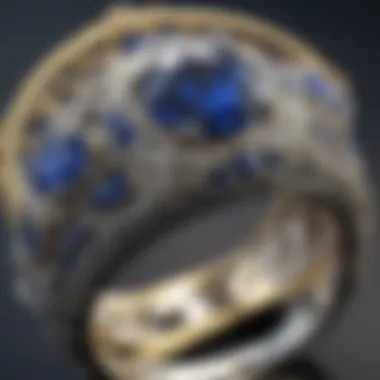
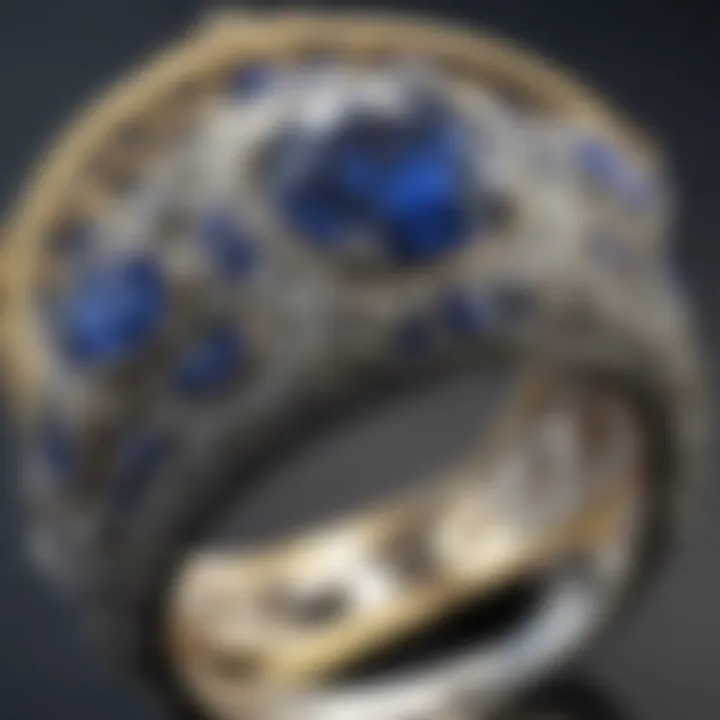
Sapphire is renowned for its diverse color spectrum. While most people associate sapphires with a rich blue hue, they are available in several colors, including pink, yellow, green, and even white. The variety in colors means there is a sapphire for nearly every personal preference. The blue sapphire, however, remains the most popular, symbolizing loyalty and trust. This color's appeal lies in its depth and clarity, which can create a striking centerpiece in an engagement ring. For those looking for personalization, colored sapphires offer uniqueness, but their value may fluctuate more than blue sapphires.
Durability and Symbolism
The durability of sapphire is one of its defining characteristics. With a hardness rating of 9 on the Mohs scale, sapphires are well-suited for everyday wear, making them ideal for engagement rings. This resilience is coupled with strong symbolism. In the 1920s, many believed that sapphires offered protection and ensured fidelity. This dual aspect of beauty and strength makes sapphire not just a gemstone but a lifelong companion in a couple's journey.
Sapphire in Historical Context
Cultural Significance
The cultural significance of sapphire stretches back centuries and involves its use by royalty and nobility. In the 1920s, this history inspired couples to choose sapphires for engagement rings instead of traditional diamonds. The gemstone symbolized sincerity and depth of emotions, aligning perfectly with the values of a new era where romantic love was celebrated. Therefore, the choice of sapphire went beyond aesthetics; it became a statement of commitment reflective of societal values.
Historical Myths and Legends
Sapphires hold a treasure trove of myths and legends from various cultures. Many believe that sapphires bring wisdom and divine favor. These legends often feature sapphires as protective stones against envy and harm, which adds another layer of intrigue to their appeal. In the 1920s, these traditions offered couples a deeper connection to their engagement rings and imbued their choices with a sense of purpose. Their historical context enhances sapphire’s importance, ensuring that these vintage pieces maintain a narrative that resonates on multiple levels.
Design Elements of 1920s Engagement Rings
The design elements of 1920s engagement rings reflect a unique blend of artistry and engineering that defines this period. In an era of profound social change, the engagement ring designs mirrored the spirit of the time, characterized by bold styles and intricate craftsmanship. Understanding these design elements is crucial for appreciating the significance of sapphire vintage engagement rings. Each element contributes not only to the visual appeal but also to the symbolic meanings associated with love and commitment.
Common Motifs and Styles
Geometric Patterns
Geometric patterns dominated the jewelry landscape during the 1920s, representing the Art Deco movement's focus on symmetry and precision. These patterns often featured sharp lines and angles, creating a visually striking effect. The use of geometric shapes gave these rings a modern and sophisticated appearance, which appealed to the progressive attitudes of the time.
The key characteristic of geometric patterns is their use of repetitive forms that interlock seamlessly, creating a sense of harmony. This style is beneficial in conveying a sense of stability and confidence, making it an ideal choice for engagement rings.
A unique feature of geometric patterns is their versatility; they can easily adapt to various gemstone settings, including sapphires. The advantages of this design include ease of pairing with modern styles, making them relevant even in contemporary jewelry. However, some might argue that the rigidity of these designs can feel less romantic compared to softer styles.
Filigree Designs
Filigree designs provide a contrast to the boldness of geometric patterns with their delicate and intricate details. This technique involves twisting thin metal wires into ornate shapes, often creating lace-like appearances. Filigree embodies the craftsmanship that was highly valued in the 1920s, allowing artisans to express creativity while showcasing their skill.
The key characteristic of filigree is its inherent delicacy. This choice is popular as it adds an element of romance and softness to engagement rings. The swirling patterns often draw the eye and highlight the center stone, such as a sapphire.
Unique features include the ability to create depth and texture, enhancing the visual complexity of the piece. Advantages of filigree designs are their stylish aesthetics and ability to invoke a sense of nostalgia. One potential disadvantage is their susceptibility to damage if not cared for properly due to their intricate nature.
Metal Choices and Settings
Platinum vs Gold
When discussing metals used in 1920s engagement rings, the choice between platinum and gold is significant. Platinum became increasingly popular for its durability and purity, making it a favorable option for holding precious stones securely. This metal's cool hue beautifully complements the rich color of sapphires, enhancing their overall appearance.
The key characteristic of platinum is its strength. This makes it a beneficial choice as it remains resistant to tarnish and wear over time. Additionally, the rarity of platinum contributes to its desirability among collectors.
On the other hand, gold offers warmth and a classic appeal. The unique feature of gold is its malleability, allowing for more intricate designs and details. The advantages of gold include its widespread availability and cultural significance. However, it is softer than platinum, leading to potential scratches and wear in the long term.
Artisan Techniques
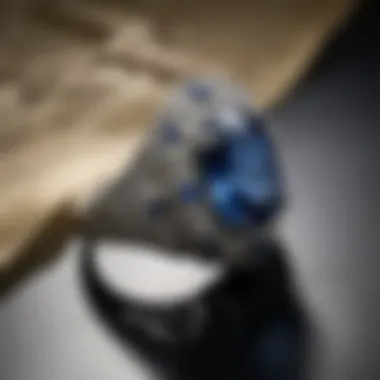
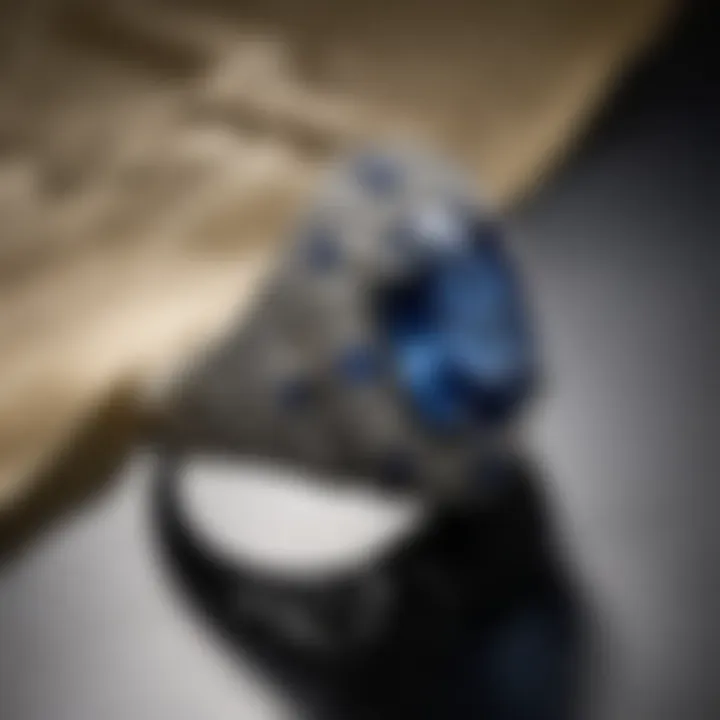
Artisan techniques played a crucial role in the creation of 1920s engagement rings. Craftsmen employed specialized skills to produce unique pieces, emphasizing individuality over mass production. The attention to detail and commitment to craftsmanship were hallmarks of this time period.
The key characteristic of artisan techniques is their ability to create personalized and customized designs. This is beneficial for couples seeking something unique in their engagement rings. Artisan techniques often involve hand-engraving or unique stone settings, making every piece a work of art.
A distinct feature of these techniques is the blend of tradition and innovation. The advantages of artisan-made rings include enhanced quality and a personal touch. However, they may come with higher costs and availability limitations, depending on the artisans' skills and reputation.
Vintage engagement rings evoke a sense of history and significance, inviting the wearer to connect with the past while celebrating love in the present.
Symbolic Meanings of Sapphire Engagement Rings
Sapphire vintage engagement rings held profound significance in the 1920s, representing not just a promise of love but also embodying deeper meanings that resonate even today. Understanding these symbolic meanings allows for a greater appreciation of these rings as more than mere adornments. This section explores the concepts of love, fidelity, protection, and wisdom, showcasing why these aspects make sapphire engagement rings truly unique relics of their time.
Love and Fidelity
The primary sentiment associated with sapphire is love. In the context of engagement rings, sapphires signify deep affection and commitment. The blue color of many sapphires has often been linked to tranquil and stable emotions, promoting trust and reliability in a relationship.
Historically, sapphires have been linked to fidelity. They symbolize commitment beyond mere words. A sapphire engagement ring serves as a promise to remain true, embodying the values that couples hold sacred. This makes sapphire not just a choice of aesthetics but also of intention.
"Sapphire is the stone of commitment, bringing clarity to love’s true essence."
Protection and Wisdom
Beyond love, sapphires are considered to possess protective qualities. Many cultures believe the stone guards against negative energies and ill intentions. Those who wear sapphire engagement rings may feel a sense of security, as these rings are thought to embody strength and protection for the relationship.
Moreover, sapphires are associated with wisdom. They are seen as a source of enlightenment and clarity of thought. This connection to wisdom augments the depth of the commitment that an engagement ring represents. Couples are often inspired by the profound meanings these stones convey, instilling a sense of purpose in their relationship.
In summary, the symbolic meanings of sapphire engagement rings extend well beyond their physical beauty. They encapsulate ideals of love, fidelity, protection, and wisdom, making them timeless tokens of commitment.
Modern Interpretations of Vintage Rings
In today's jewelry market, vintage engagement rings hold a significant allure, especially those from the 1920s era. The revival of vintage styles in contemporary design reflects a growing appreciation for artistry and history. Such pieces are not merely adornments; they resonate with emotions and memories. Consumers are increasingly drawn to the notion that these rings represent stories and legacies rather than just trends.
Revival of Vintage Styles in Contemporary Design
Modern jewelry designs often incorporate elements from the 1920s, merging classic sophistication with fresh creativity. This revival manifests in various ways. Designers integrate geometric patterns, filigree, and the exquisite use of sapphires into their work. These vintage-inspired styles appeal to buyers who value timelessness over fleeting fashions. Additionally, bespoke jewelry options have increased, allowing individuals to personalize their vintage-inspired designs.
An important aspect of this revival is the emphasis on sustainable practices. Many consumers are conscious of their choices, supporting the use of ethically sourced materials. Vintage engagement rings naturally align with these values, minimizing the need for new mining. Hence, engagement rings from the 1920s become not just loved items but also sound investments.
Sourcing Authentic Vintage Pieces
Finding authentic vintage engagement rings can enhance any collection. Many enthusiasts look to antique dealers and online marketplaces to locate true 1920s pieces. Both avenues present unique advantages and challenges.
Buying from Antique Dealers
Buying from antique dealers provides a direct connection to the history of the piece. These dealers often have extensive knowledge about their inventory, offering insights into the origins and craftsmanship of the rings. This is especially beneficial when authenticity is a primary concern.
A key characteristic of this approach is the personal touch. Many antique dealers cultivate relationships with their clients, helping them find the perfect piece that matches their needs. However, it is essential to research the dealer’s reputation and experience. The main advantage is assurance of authenticity, but prices can be higher than other sources.
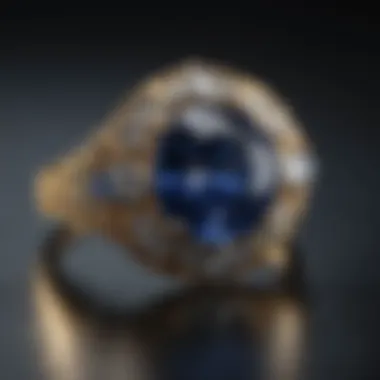
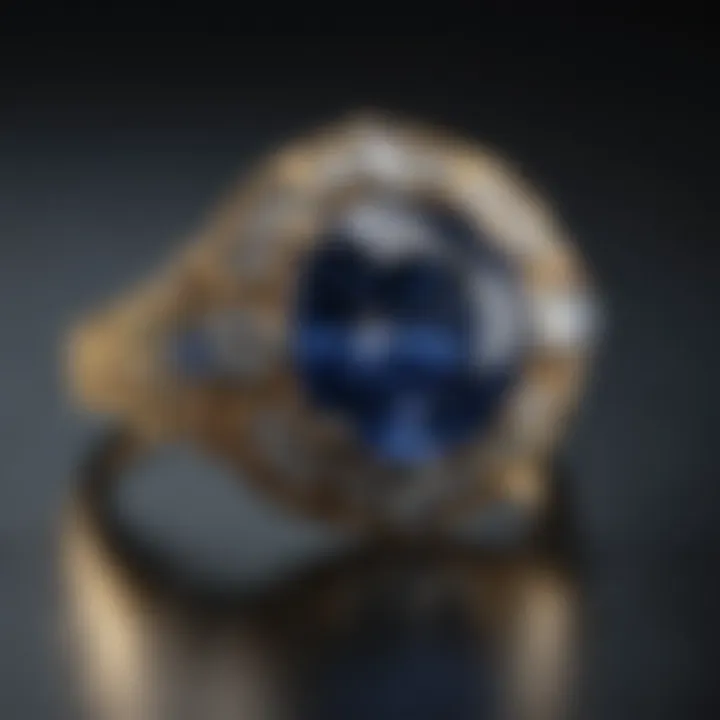
Online Marketplaces
Online marketplaces offer a modern way to discover vintage engagement rings. Platforms like eBay or specialized jewelry sites provide access to a vast array of options. The convenience of browsing from home allows collectors to explore different styles and price ranges quickly.
One major advantage here is the ability to compare prices and find deals. However, buyers must exercise caution. The risk of fraud or misrepresentation is a challenge. Ensuring that sellers have good reviews and return policies can mitigate these risks. Therefore, while online marketplaces can yield excellent finds, potential buyers need to be diligent in verifying the authenticity of their selected pieces.
Caring for Sapphire Vintage Engagement Rings
Caring for sapphire vintage engagement rings is essential for maintaining their beauty and value. These rings, often crafted with meticulous artistry, are not only sentimental treasures but also potential investments. Understanding how to care for them properly can enhance their longevity and aesthetic appeal.
Cleaning and Maintenance
Cleaning sapphire vintage engagement rings necessitates a gentle approach. The goal is to preserve both the sapphire and the metal settings without causing damage. \ Generally, a simple solution of mild dish soap and warm water can be effective. Use a soft brush, like a toothbrush with soft bristles, to clean the settings and stones gently. Rinse thoroughly with clean water and dry with a soft, lint-free cloth.
Avoid harsh chemicals or abrasive materials, as these can scratch the surface or dull the brilliance of the sapphire. It is also wise to refrain from using ultrasonic cleaners, especially if the ring has delicate designs or is set with other gemstones. Regular cleaning can help prevent dirt build-up and keep the ring looking its best.
Tip: Clean the ring every few weeks, especially if worn daily, to keep any grime from tarnishing its beauty.
Long-term Preservation Tips
To ensure that sapphire vintage engagement rings remain vibrant and intact over the years, several long-term preservation strategies can be applied.
- Proper Storage: When not being worn, rings should be stored in a jewelry box or a clean, soft pouch to prevent scratches. Avoid placing several pieces in one container to minimize the risk of entanglement or abrasion.
- Limit Exposure to Chemicals: Everyday products like perfumes, lotions, and cleaning agents can damage the metal and stones over time. It is advisable to remove the ring during activities involving chemicals or vigorous physical activities.
- Routine Inspections: Periodically check for loose stones or wear on the setting. If you observe any issues, consult a professional jeweler immediately. Early intervention can prevent further damage.
Investing attention in the care of sapphire vintage engagement rings ensures their beauty and integrity remain intact for future generations. A well-cared-for ring not only serves as a lasting symbol of love but can also maintain or increase its market value over time.
Investing in Sapphire Vintage Rings
Investing in sapphire vintage rings offers a unique intersection of beauty, history, and financial opportunity. The allure of these rings transcends mere aesthetics, engaging both collectors and enthusiasts alike. Understanding the market can lead to significant benefits, such as appreciating value over time. Sapphire engagement rings, especially those from the 1920s, not only tell a story but also serve as a tangible asset that can appreciate in worth.
When it comes to investing, one must consider several critical elements. These include condition, provenance, and market trends. Condition directly impacts the overall value of a ring. A well-preserved piece can fetch a higher price compared to one that shows signs of heavy wear. Provenance adds a layer of storytelling, potentially increasing desirability among collectors. Lastly, awareness of current market trends helps investors make informed decisions, allowing them to identify when to purchase or sell.
Market Trends for Vintage Jewelry
The vintage jewelry market has seen a resurgence in recent years. Factors such as nostalgia and the growing appreciation for craftsmanship drive demand. Buyers are seeking authenticity and unique stories. Sapphires, particularly given their vibrant colors, are exemplars of this vintage trend. Trends often fluctuate, but certain types of vintage rings consistently attract attention, such as those featuring intricate designs typical of the Art Deco period.
Investment in sapphire vintage rings can also be influenced by notable fashion influences and celebrity endorsements. As designers highlight such rings in modern collections, the market responds favorably. Moreover, the rise of social media platforms, such as Instagram, has made it easier for collectors to showcase their pieces. Enthusiasts often engage in discussions about market values, which can further uplift prices.
Evaluating Value and Authenticity
Investing wisely in vintage rings requires a clear understanding of their value and authenticity. This includes obtaining proper certification and appraisal for each piece.
Certification and Appraisal
Certification plays a crucial role in verifying a sapphire's authenticity and quality. Rings that come with certification from reputable gemological institutes have a significant advantage in the marketplace. This certification details the magic aspects of the sapphire, including color, clarity, cut, and carat weight. Having such reports adds transparency to the value of the ring.
Appraisal also signifies worth. A professional appraisal can provide potential buyers with insights into market value. Often, appraisers are gemologists with specialized training, making their assessment a sound choice for investors. However, it's essential to ensure that the appraiser has credibility and relevant experience in vintage jewelry.
"Sapphire certification not only validates authenticity but also equips investors with knowledge about their investment's true worth."
Identifying Reproductions
One key consideration in investing is identifying reproductions. As vintage designs gain popularity, counterfeit versions proliferate. Recognizing these reproductions is vital to protecting one's investment. Authentic vintage rings will typically have characteristics reflective of the era's craftsmanship.
To identify reproductions, look for inconsistencies in design details, weight, and even the settings. Also, consultation with experts who have experience in vintage jewelry can prove invaluable. Familiarity with specific markings or characteristics commonly found in genuine 1920s designs serves as a useful guideline. While reproduction pieces may offer aesthetic value, they do not hold the same market potential as authentic rings.



